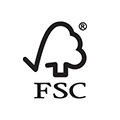Montessori beds have become quite popular in recent years. Almost every kids’ store or children’s furniture manufacturer has them in their catalog and promotes them as a beneficial option worth considering.
What exactly are Montessori beds though? What benefits do they offer? Are they safe? When should you invest in one and how do you pick the right one? Well, wonder no more. Come along as we answer these and other pertinent questions and demystify Montessori beds.
What is Montessori-style Sleeping?
The Montessori concept dates back to the 20th century and was spearheaded by Dr. Maria Montessori. It began as an alternative approach to children’s education. It encourages a curriculum that focuses more on children’s needs, cultivates independence, and allows more hands-on participation by kids. Later, Dr. Montessori expanded the concept through research to address safe and healthy sleeping practices.
Just like Montessori learning, Montessori-style sleeping encourages children to be independent and curious to explore but under the safety of adult care. It achieves this through its unique principles:
- Autonomy: Through independent sleeping for toddlers in a safe space.
- Floor beds: They make it easier and safer for toddlers to get on and off their beds independently.
- Minimalism: Creating inviting and comfortable sleeping spaces for toddlers without clutter.
- Self-regulation: Allowing children to sleep when they are tired helps their body develop a sleep routine.
The floor beds concept for kids emerged from Dr.Maria’s research and recommendations. This is why they are now known as Montessori beds.
What is a Montessori Bed?
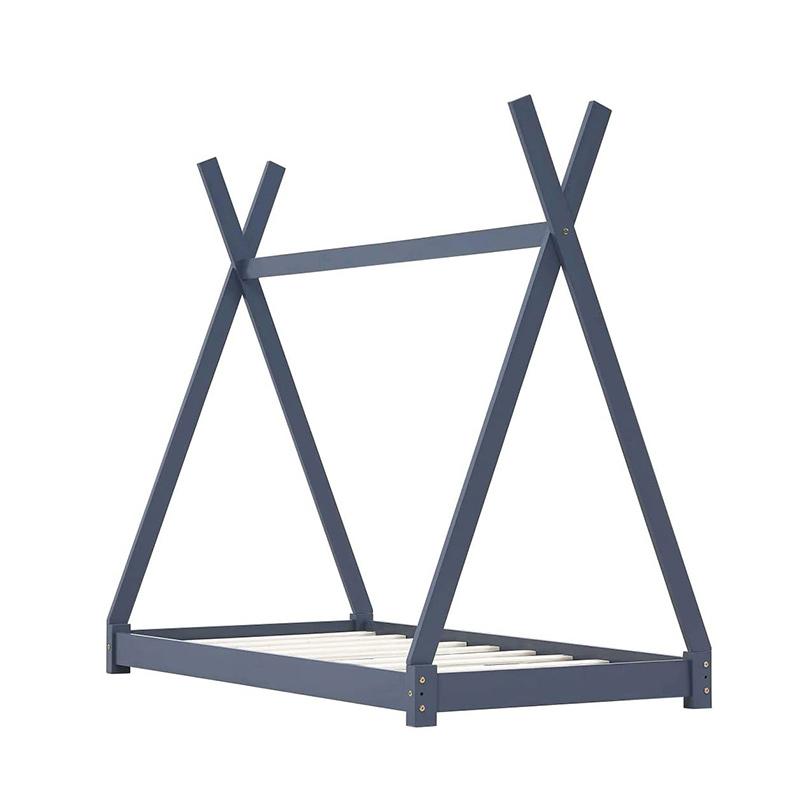
A Montessori bed is a toddler bed design inspired by the Montessori sleep principles. The designs usually have common features such as:
1. Proximity to the floor: A Montessori-style bed either lies flush against the floor or has a very small elevation from the floor. The height should allow toddlers to easily get on and off the bed by themselves.
2. No restrictions: Montessori beds have no railings on the sides. Alternatively, if there are railings, they should not be on the side of the bed that a child would use to climb on or off. This encourages free movement. Railings are also fairly unnecessary because the low height of Montessori beds does not pose the risk of injurious falls.
The design details such as the size or decorative aspects of the bed may differ from one manufacturer to the next. However, these two main concepts are what distinguish a Montessori-style bed from other toddler beds or cribs.
Pros and Cons of Montessori Bed
Pros
Promoting Independence: The low height of Montessori beds helps children learn that they can get on and off their beds when they need to. They, therefore, no longer need to cry because they feel stuck in a crib when they wake up.
Freedom of Movement: Children get even more curious and keen to explore as soon as they can crawl or walk. Montessori beds provide freedom for them to move around their sleeping areas safely. They work particularly well if you execute the full Montessori sleep area concept by child-proofing the room and keeping it free of clutter.
Calmer Sleep Transitions: Montessori beds can help make transitions to independent sleeping less scary for toddlers. The ease of movement reassures the child because they know that they can get up and come to you whenever they need to.
Minimal Risk: The proximity of Montessori beds to the floor and the lack of restrictive railing eliminate this risk and instead encourage safe exploits.
Cons
The Risk of Unchecked Freedom: It is easy for toddlers to wake up and wander around the house if there are no limitations once they get off their Montessori beds.
Unusual Sleep Patterns and Locations: When toddlers discover their freedom, it is not uncommon for them to get cheeky with it. They can choose to wake up and play at dawn and fall asleep again by morning when it is time to get on with the day. They may also fall asleep in strange places like their play area or other parts of the house if they wander.
Draught and Allergens: Homes with elevated doors bring in gusts of cold air which can be uncomfortable for anyone sleeping at floor level let alone a toddler. The proximity of Montessori beds to the floor can equally expose children to dust or allergy-inducing carpet fibers.
What Age Is the Montessori Bed Suitable For?
Montessori sleep principles do not specify the age when parents should transition toddlers from co-sleeping, cribs, or bassinets to floor beds. This is not surprising because the Montessori sleep approach is all about reasonable flexibility. However, you can make this decision based on what you feel is right for your child and recommendations from health experts.
For example, the American Academy of Paediatrics does not prioritize the type of bed that you should choose. They emphasize the following safe sleeping practices instead:
- A firm evenly flat mattress
- A tightly fitted sheet (for infants)
- No extra loose bedding or toys (for infants)
- Place infants on their backs during sleep
- No pillows for children under 2
You and your child may also be able to enjoy the safety and developmental values of a floor bed when they can crawl or walk. This is probably why most parents begin the transition around 18 months.
Is a Montessori Bed Safe?
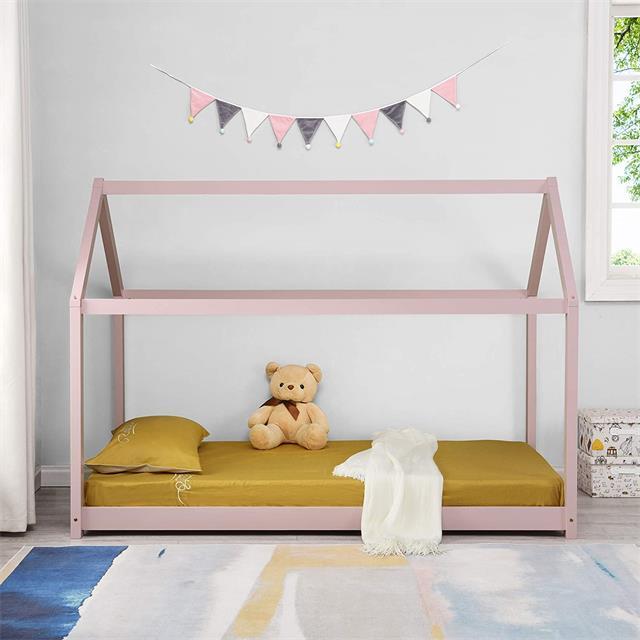
Yes.
A Montessori bed built with no restrictions and proximity to the floor is safe. Montessori beds allow children to get on and off beds without the risk of injury. They are arguably safer than cribs where a child could get stuck or injured if they attempted to get on or off without the assistance of a caregiver.
As a parent or a caregiver, if the thought of a Montessori bed makes you anxious, you can take steps to make the space even safer for your child. Let’s look at a few of these measures, shall we?
Use Plush Carpeting
Placing a hypoallergenic carpet near a Montessori bed can allay your fears of falls. A padded or fairly thick carpet is ideal for this as it would cushion the child adequately. Ensure that the rug or mats used are non-slip to prevent tripping hazards. Secure them properly to the floor to avoid any movement that could cause the child to stumble or fall.
Carry out Child-proofing Measures
Child-proofing the room can make the space safer and minimize the risk of unhindered freedom. Please consider:
- Sealing power outlets
- Removing all clutter from the space including cords and choking hazards
- Allowing only child-safe toys in the room
- Including only minimal and child-safe furniture in the room
Consider Adding Safety Rails (optional)
Although one of the characteristics of a Montessori bed is that it has no restrictive rails. If you think your child is too young to be independent, consider a bed with rails.
Some manufacturers understand this concern of parents and give consumers plenty of options when manufacturing. Some Montessori bed styles come with removable rails, which can usually be installed temporarily and removed as the child grows and becomes more confident in their movements. If using rails, consider using soft or padded rails to avoid any hard surfaces near the sleeping area. These rails should be high enough to prevent children from rolling off, but low enough to allow them to climb in and out independently.
How to Choose a Montessori Bed
You will find an extensive array of options when you begin shopping for a Montessori bed. Most designs are also so alluring that you easily get drawn in and wonder how to make the right pick. So, let’s discuss some pointers to help identify the best Montessori bed for your little one.
Use the Montessori Sleep Principles
There are tons of floor beds in the market but not all of them are Montessori beds. You see, a bed has to meet the Montessori sleep principles to qualify as a Montessori bed. So, aim for a floor bed that has enough proximity to the floor that a toddler can climb on or off unaided. It should also not have wrap-around barriers or railings; especially along the climbing side as this would limit the child’s movement.
Consider Aeration
Choosing a Montessori bed with a slight elevation off the floor makes it easy to properly clean the space and prevents the formation of mildew under the mattress.
Select Safe Durable Materials
Children play in their beds all the time. It is thus ideal to choose a toddler bed made using sturdy durable materials that can handle a few bounce-off sessions. Aim for safe materials too such as wood that does not splinter and non-toxic paint finishes. Round edges are equally important to prevent impact injuries.
Pick the Right Size
Prioritize Montessori beds that will fit the space you have in your home. It is also advisable to choose a bed size that your child can comfortably enjoy for a few years unlike one that they will outgrow when during their toddler growth spurt.
Most Popular Montessori Bed Styles
Some Montessori bed styles are more popular because of their outstandingly beautiful designs and their high functionality. Such popular designs include:
Montessori Floor Beds
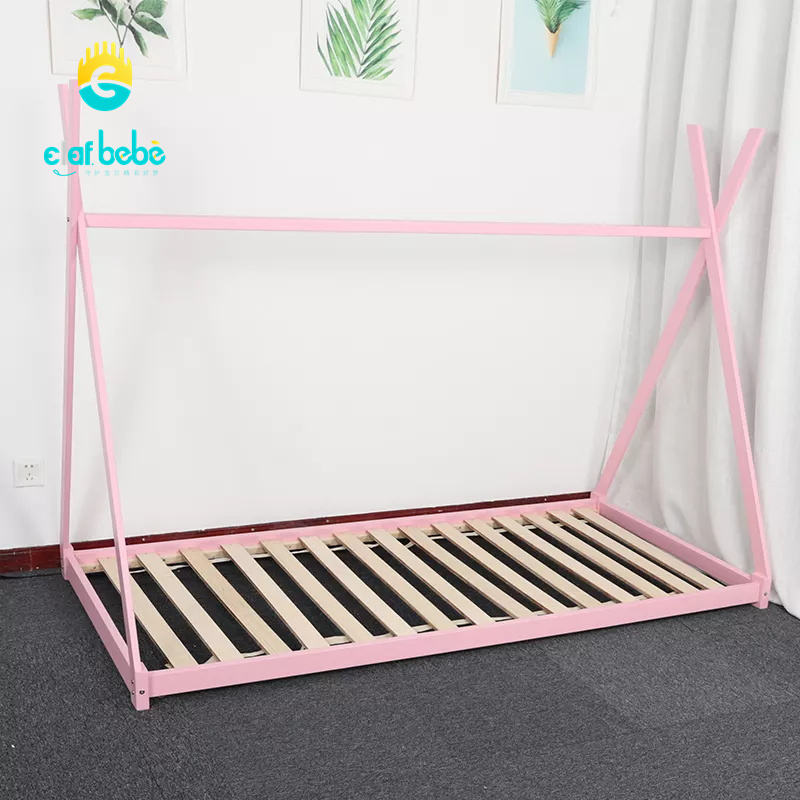
Montessori floor beds sit flush on the floor of a room and may or may not have a bed frame. They are a great pick if you would like a simple minimalist look for your child’s sleeping area. They also have no weight restrictions because the floor bears all the weight; your child can thus enjoy such a bed for longer.
Montessori House Beds
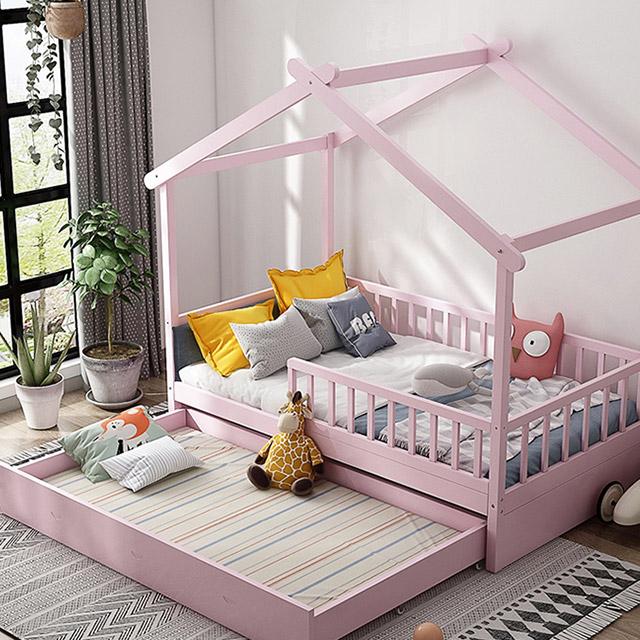
Montessori house beds have decorative frames that resemble a house. The design typically includes a roof-like structure and open sides, creating a cozy, playhouse-like environment for the child. Children enjoy them because they give the grand feeling of owning a house instead of just a sleeping space. They can decorate them with child-safe toys, fairy lights, and other additions as they get older which makes the space even more exciting for them.
Montessori Canopy Beds
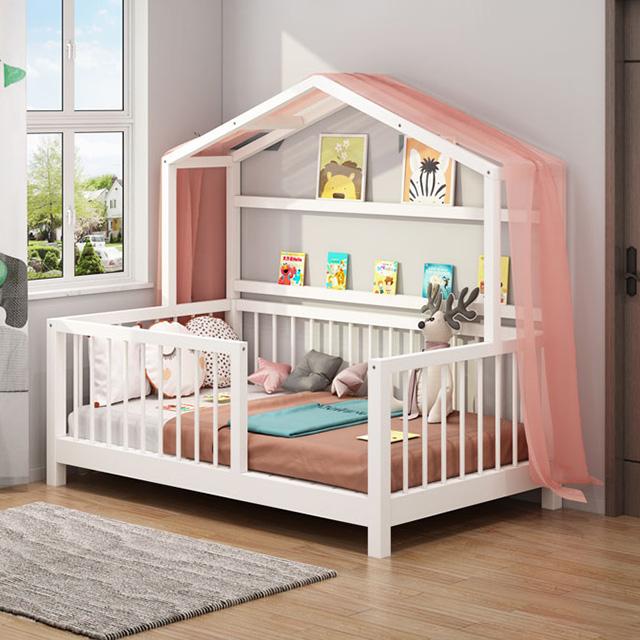
A Montessori canopy bed has an overhead frame that resembles a house. You can drape the frame with decorative fabric to create a canopy. The canopy can be made from fabric, wood, or other materials, creating a sheltered and intimate space for the child, or you can request your Montessori bed manufacturer to customize this detail for you.
Like house beds, Montessori canopy beds give children a sense of adventure and ownership. This is great for fun but also helps make the transition to independent sleeping easier.
What is the Right Mattress Size for a Montessori Bed?
The right mattress size for a Montessori bed depends on the size of the Montessori bed.
Initially, crib-size mattresses measuring 28″ by 52″ or twin-size mattresses measuring 38″ by 75″ were the standard picks for Montessori beds.
However, Montessori bed sizes and designs vary quite a bit. It is thus best to establish the size of the Montessori bed you choose and then select an appropriate mattress size for it. Regardless of the size, the mattress should be firm yet comfortable to support the child’s developing spine, and made from non-toxic, breathable materials to align with the Montessori emphasis on natural, child-safe environments.
How to Create a Montessori-style Bedroom for Your Child?
As we have established, the Montessori approach is not limited to investing in a floor bed. The bed only facilitates the Montessori ideas of sleep which include promoting independence, freedom, and safe sleeping. Creating a sleeping space that embodies these ideas is what brings the Montessori style full circle. Here is how to do it.
Items That Need to Be Prepared
| Furniture | A Montessori floor bed Low-height child-friendly tables and chairs for activities |
| Organizational Tools | A basket or lightbox to store toys Child-accessible shelves and drawers for books, crayons, etc. |
| Educational and Play Materials | Books Stationery for doodles and drawings Crayons and colored pencils |
| Safety Provisions | Accessible or motion-activated night lights Bedroom gate A play mat A bedside mat |
Step-by-Step Guide
1. Prepare the Room: Envision the kind of sleeping space you would like to create. Install any decorative features such as wallpaper or special flooring first and give the room adequate time to air out. Install the safety features such as power outlet covers and the bedroom door gate. Take away all cords and clutter from the room and then clean up.
2. Install Furniture: Montessori beds are often safer if you position them against a wall; it leaves only one side for the child to get on or off the bed hence presenting a smaller risk. Place the bedside mat along the climbing side. Set up the play area with the furniture, toys, and activity essentials on the other side of the room. This separates the sleep and play zones.
3. Decorate the room: Choose calming, neutral tones for the walls and furniture to create a peaceful environment. Avoid overly bright or stimulating colors. Hang art or photographs at your child’s eye level, allowing them to appreciate and engage with the visuals. Maximize natural light in the room. Use sheer curtains to soften the light, making the space feel bright and airy.
4. Incorporate Practical Life Activities: Set up a small mirror with a brush, comb, and tissues. This encourages self-care and personal responsibility. Provide child-sized cleaning tools like a broom, dustpan, or cloth, allowing your child to help with tidying up.
5. Conduct a Safety Check:
- Check your safety installations to ensure they work properly.
- Keep everything that the child needs within their reach to ensure safety.
- Anything you spot that they do not need is superfluous and it is best to remove it from the room.
Conclusion
The Montessori approach to child-rearing can feel daunting because it gives toddlers lots of freedom. The truth, however, is that this freedom gives them a safe space to learn and is much healthier than helicopter parenting. So, if you are weighing options on whether to transition to Montessori beds, go ahead and give it a try. The safety tips in this blog will help you get it right.
On the other hand, if you have been wondering whether to stock Montessori beds in your store, the answer is yes.
Clafbebe is a well-known Montessori bed manufacturer in China, producing Montessori beds that exceed international quality and safety standards. Their safety and appeal are bound to remain in demand for years to come. Contact us for details on our collections and a quote at any time.
Recommended Related Articles:




